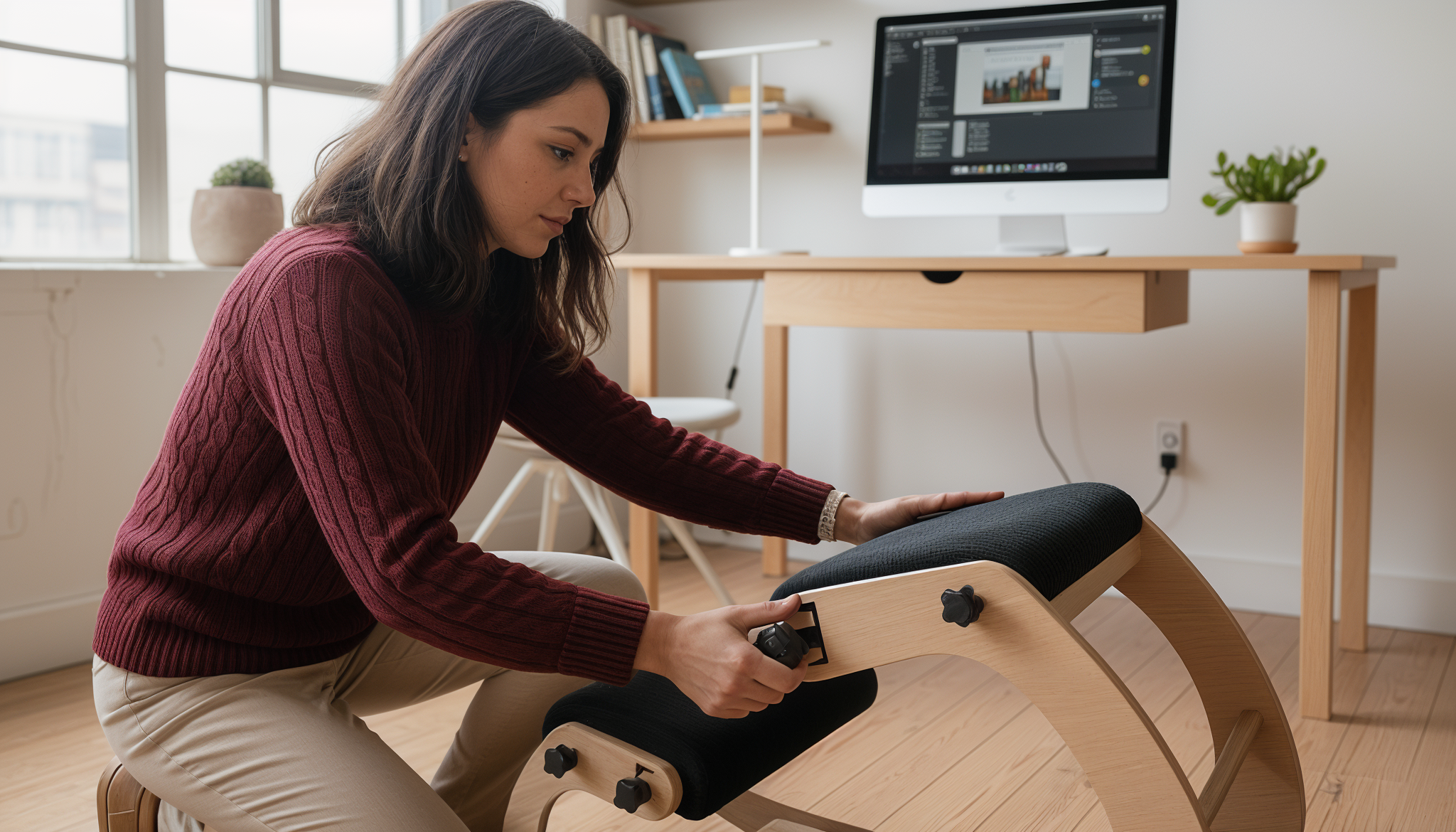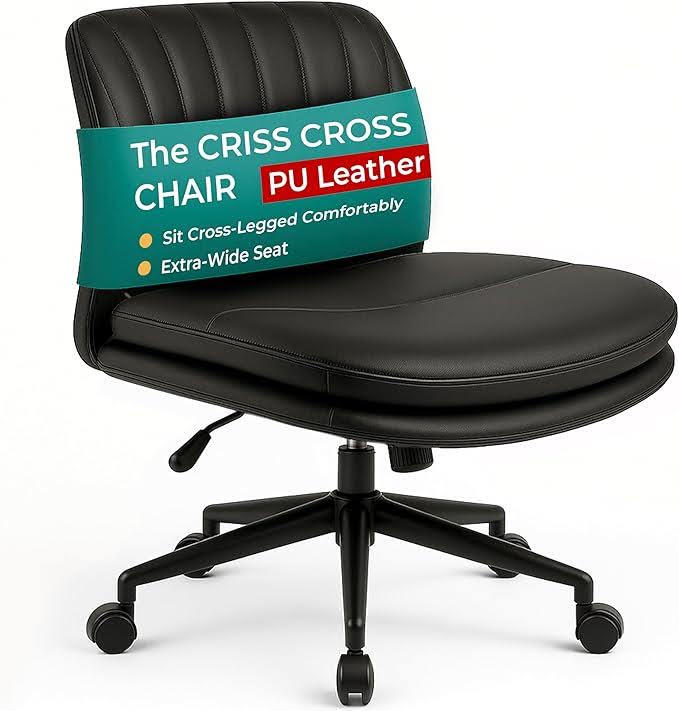In our previous guide on understanding kneeling chair ergonomics, we explored the biomechanical principles behind active sitting—how the open hip angle reduces spinal pressure, why weight distribution matters, and what the research shows about postural health.
But knowing the science is only half the equation. The real question is: How do you actually integrate this into your daily workspace routine?
If you’re considering a kneeling chair—or already have one sitting in the corner because the first attempt felt awkward—this guide is for you. The transition to active sitting doesn’t have to be complicated or uncomfortable. With the right approach, most people adapt comfortably within 2-3 weeks and never look back.
At ErgoLife Foundation, we’ve studied the adaptation process and gathered insights from ergonomic research on postural transition. This guide walks you through the practical steps to make your kneeling chair a natural, comfortable part of your workspace.
What You’ll Learn in This Guide:
- → Why adaptation matters: Setting realistic expectations
- → The gradual approach: Your week-by-week plan
- → Proper positioning: Getting the setup right
- → Optimizing your desk height
- → Creating your position variation strategy
- → Troubleshooting common challenges
- → Long-term benefits: What to expect after adaptation
- → Your action plan: Getting started today
Why Adaptation Matters: Setting Realistic Expectations
Your body has spent years—maybe decades—adapting to traditional seating. Your muscles, joints, and nervous system have developed patterns around sitting at 90 degrees with full back support.
A kneeling chair asks your body to do something different:
- Engage muscles that have been “sleeping” – Your core stabilizers need to gently activate
- Lengthen muscles that have shortened – Hip flexors begin returning to healthier range
- Build new postural awareness – You become more conscious of how you hold your body
- Develop balance reflexes – Subtle adjustments throughout the day improve stability
This isn’t difficult or painful—it just takes time. Think of it like starting a gentle fitness routine rather than forcing an overnight change.
The good news? Once adapted, these benefits become automatic. Your body learns to prefer the upright, active position.
Adaptation Timeline
Most people fully adapt to kneeling chairs within 2-3 weeks with gradual introduction. Week 1 focuses on exploration, Week 2 builds endurance, and by Week 3-4 it becomes natural.
The Gradual Approach: Your Week-by-Week Plan
Week 1: Introduction and Exploration
Goal: Let your body experience the new position without overwhelming it.
How to do it:
- Start with 20-30 minute sessions, 2-3 times throughout your workday
- Alternate between your kneeling chair and traditional seating
- Pay attention to how your body feels without judging the experience
- Focus on finding comfortable positioning (we’ll cover this below)
What to expect:
- Mild muscle awareness in your core and shins—this is activation, not pain
- Increased alertness and focus during kneeling chair sessions
- Natural fidgeting as your body explores the new position
- Questions about whether you’re “doing it right” (totally normal!)
Key insight: This week is about curiosity and exploration. Your body is gathering information.
Week 2: Building Endurance
Goal: Gradually increase time as your postural muscles build strength.
How to do it:
- Extend to 45-60 minute sessions, 3-4 times daily
- Continue alternating with other positions (traditional chair, standing breaks)
- Experiment with small position adjustments to find what feels best
- Notice which times of day feel most comfortable for the kneeling chair
What to expect:
- Reduced muscle soreness as your core strengthens
- More natural-feeling posture—less conscious effort required
- Better ability to maintain focus during longer sessions
- Beginning to sense when you need a position change
Key insight: Your muscles are adapting. What felt tiring last week now feels manageable.
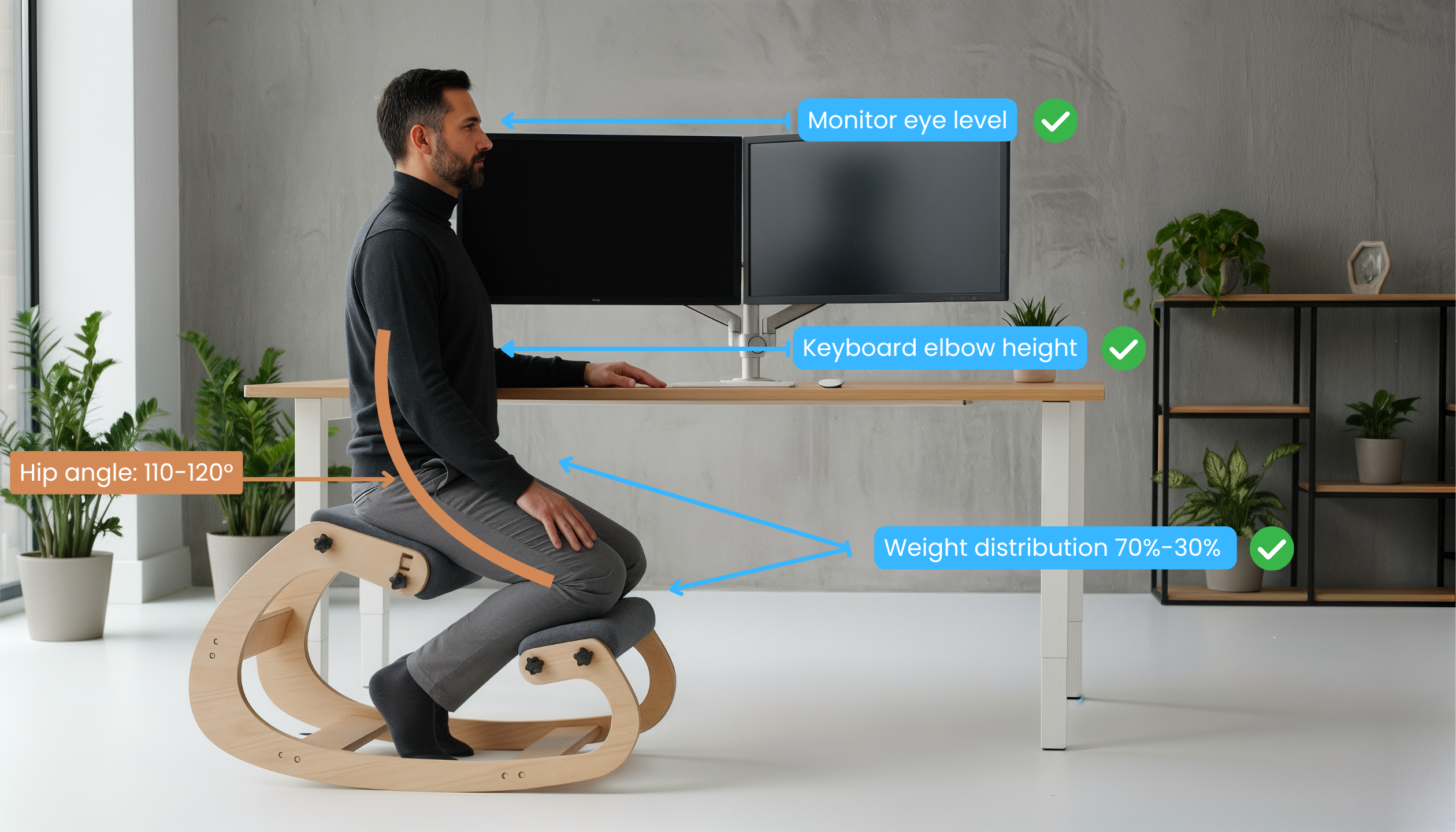
Proper positioning is key to comfortable adaptation
Week 3-4: Integration Phase
Goal: Make the kneeling chair a natural part of your workspace routine.
How to do it:
- Use the kneeling chair for 1-2 hour blocks as comfortable
- Choose it strategically for tasks requiring focus or upright posture
- Develop your personal rhythm of position variation
- Notice improvements in your overall posture throughout the day
What to expect:
- Comfortable extended use without fatigue
- Automatic micro-movements and position adjustments
- Better posture even when using your traditional chair
- Reduced end-of-day stiffness compared to your old routine
Key insight: The kneeling chair is becoming a trusted tool, not an experiment.
Free Workspace Assessment
Get personalized seating recommendations from certified ergonomic specialists. No sales pitch, just evidence-based guidance.
Schedule Your Free AssessmentQuick Setup Checklist
- ✓ 60-70% weight on buttocks, 30-40% on shins
- ✓ Hip angle: 110-120 degrees (more open than traditional 90°)
- ✓ Shins comfortable on pads, knees not compressed
- ✓ Forearms parallel to floor when typing
Proper Positioning: Getting the Setup Right
Correct positioning makes the difference between comfortable adaptation and unnecessary struggle. Here’s what matters:
Weight Distribution: The 60/40 Rule
As we discussed in our guide on kneeling chair biomechanics, proper weight distribution is crucial:
- 60-70% on your buttocks
- 30-40% on your shins
How to check: When seated, you should feel most pressure on your buttocks, with your shins providing support but not bearing your full weight. If you feel like you’re kneeling (shins doing most of the work), raise your seat height slightly.
Shin Pad Positioning
Your shins should rest comfortably on the pads:
- Not too high – Your knees shouldn’t feel compressed
- Not too low – You shouldn’t feel like you’re sliding forward
- Just right – Comfortable contact with natural weight distribution
Most quality kneeling chairs allow shin pad adjustment—use it to find your optimal position.
Seat Height and Angle
Adjustable kneeling chairs offer flexibility here:
- Seat height: Your hips should be elevated above your knees
- Seat angle: A forward tilt of 20-30 degrees is typical
- Hip angle: Aim for the 110-120 degree opening that creates the postural benefits
Foot Position
Your feet can rest lightly on the floor behind you or hang freely—either works. The key is that they’re not bearing significant weight.
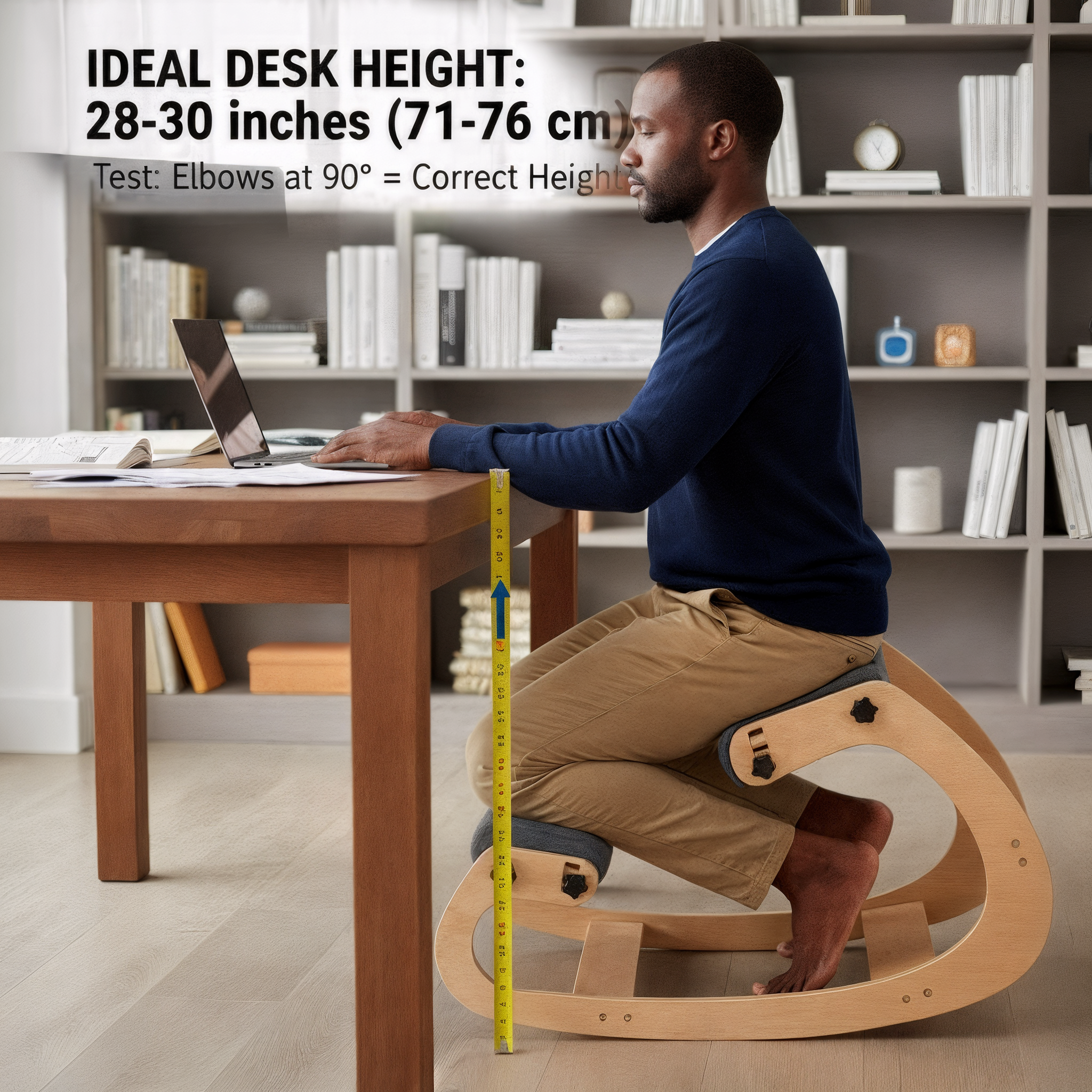
Proper desk height is critical for comfort
Optimizing Your Desk Height
The elevated sitting position of a kneeling chair changes your relationship to your work surface. Desk height becomes critical for comfort.
The Ideal Setup
When seated in your kneeling chair:
- Your forearms should be roughly parallel to the floor when typing
- Your wrists should remain neutral (not bent up, down, or sideways)
- Your shoulders should feel relaxed, not elevated or hunched
If Your Desk Is Too High
Solutions:
- Raise your kneeling chair to its maximum height
- Add a keyboard tray that lowers your keyboard and mouse surface
- Consider an adjustable-height desk for ultimate flexibility
If Your Desk Is Too Low
Solutions:
- Lower your kneeling chair (if adjustable)
- Add risers under your desk legs (typically 2-4 inches)
- Use a laptop stand to raise your screen while maintaining keyboard at proper height
Monitor Positioning
The upright posture naturally elevates your eye level:
- Position your monitor so the top of the screen is at or slightly below eye level
- Maintain 20-26 inches distance from your eyes to screen
- For laptop users: An external monitor or laptop stand becomes especially valuable
Creating Your Position Variation Strategy
As we’ve emphasized in our previous guide on active sitting, no single position—no matter how ergonomically sound—should be maintained all day. Your body craves movement and variety.
The 50/25/25 Approach
Research on dynamic workstations suggests this distribution:
- 50% Kneeling Chair – Your primary position for focused work
- 25% Traditional Chair – For more relaxed tasks or core rest breaks
- 25% Standing/Moving – Brief standing periods, walking breaks, stretching
Strategic Position Selection
Different positions serve different work needs:
Use your kneeling chair for:
- Writing, coding, or creating content
- Video calls (the upright posture enhances your professional presence)
- Detailed analytical work requiring sustained concentration
- Tasks where alertness and focus matter most
Switch to traditional seating for:
- Reading or consuming content
- Casual phone calls or relaxed meetings
- Deliberate breaks when you want to fully rest your core
- Times when you’re already physically fatigued
Stand or move for:
- Phone calls or brainstorming sessions
- Brief breaks every 45-60 minutes
- Transitions between major tasks
- Moments when you need an energy boost
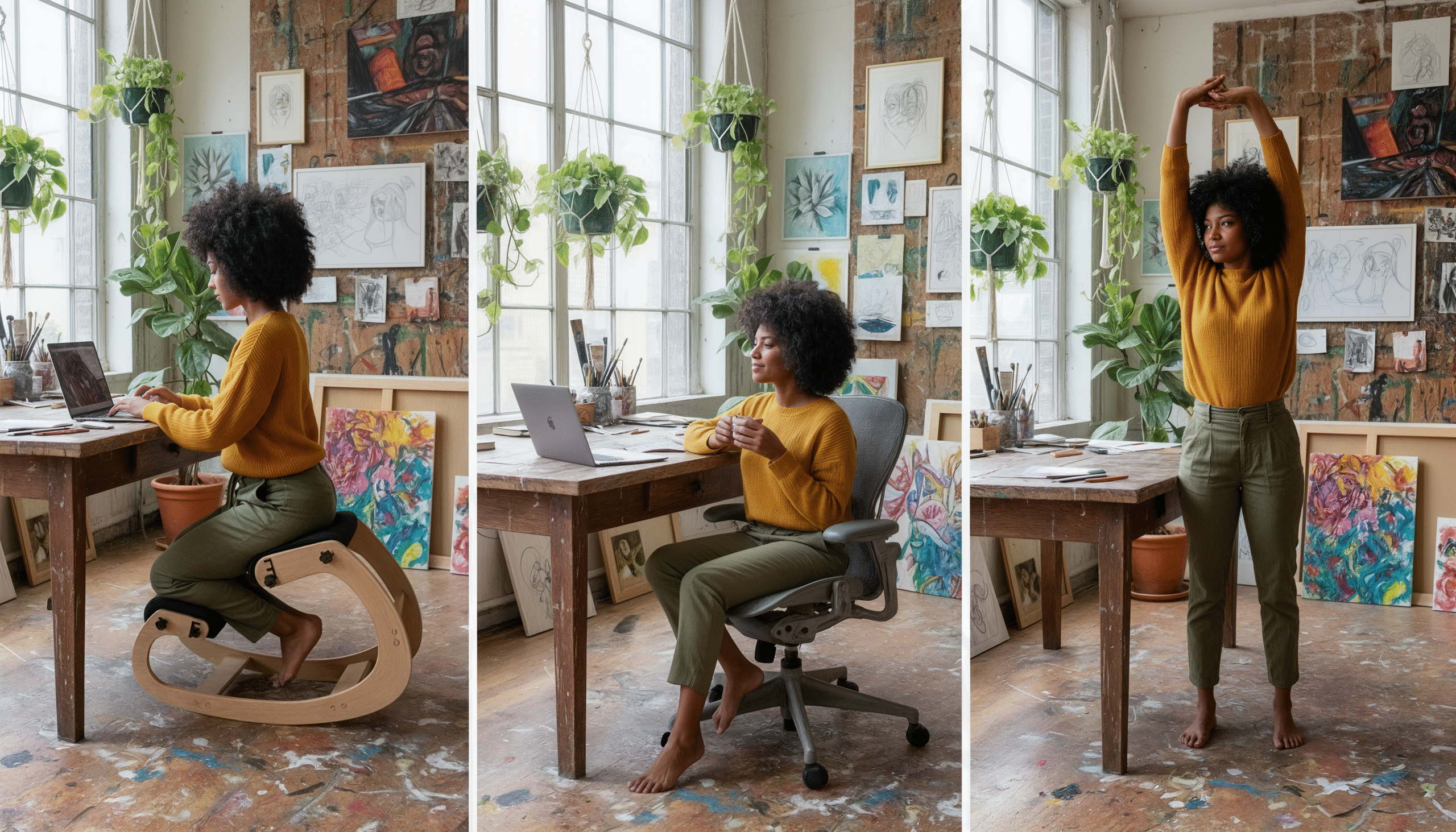
A dynamic workspace supports multiple positions
The 50/25/25 Rule
Kneeling Chair
Primary position for focused work
Traditional Chair
Relaxed tasks, core rest breaks
Standing/Moving
Walking breaks, stretching
Troubleshooting Common Challenges
“My shins feel sore after 30 minutes”
Likely cause: Too much weight on your shins rather than your buttocks.
Solutions:
- Verify your seat is high enough—most people start too low
- Check that shin pads have adequate padding
- Ensure you’re sitting forward on the seat, not leaning back
- Consider adding a thin cushion to shin pads if needed
“My core feels tired quickly”
Likely cause: Your core muscles are building strength—this is normal and temporary.
Solutions:
- Shorten your sessions during weeks 1-2 while muscles adapt
- Take standing breaks between kneeling chair sessions
- Do gentle core stretches during breaks (cat-cow, child’s pose)
- Remember: this fatigue disappears within 2-3 weeks
“I feel unstable, like I might fall forward”
Likely cause: The open hip angle creates an unfamiliar sensation initially.
Solutions:
- Double-check that shin pads are properly positioned
- Verify your seat is at the correct height
- Engage your core gently to maintain upright position
- Give it 3-5 days—this sensation disappears as your body adapts
“My knees hurt”
Stop and reassess immediately:
Knee pain (actual pain, not mild pressure) suggests setup issues:
- Check that knees aren’t compressed between seat and shin pads
- Verify shin pads rest on your shins, not your knees
- Ensure adequate padding on shin contact points
- If pain persists, consult an ergonomic specialist or healthcare provider
Download Our Complete Ergonomic Workspace Guide
Get our free 25-page Complete Ergonomic Workspace Guide with comprehensive assessment checklist and 12 illustrated desk exercises.
Download Free PDF GuideWho Benefits Most? Tailoring to Your Needs
In our previous guide on kneeling chair ergonomics, we covered who benefits from this seating style. During the adaptation phase, certain groups tend to transition more easily:
Faster Adaptation (1-2 weeks):
- People with existing core strength from exercise or sports
- Those already interested in active sitting or standing desks
- Individuals with flexible, adaptable posture habits
- Anyone transitioning from other ergonomic solutions
Longer Adaptation (3-4 weeks):
- Those with weak core muscles from years of sedentary work
- People with very tight hip flexors from prolonged 90-degree sitting
- Individuals with previous back injuries (though kneeling chairs often help long-term)
- Those with deeply ingrained postural habits to unlearn
Neither timeline indicates success or failure—your body simply adapts at its own pace. Be patient with your process.
Supporting Your Adaptation: Beyond the Chair
Complementary Stretches
These stretches support the muscle groups involved in active sitting:
Hip Flexor Stretch Kneel on one knee, push hips forward gently. Hold 30 seconds each side, twice daily. This counteracts years of hip flexor tightness.
Cat-Cow Stretch On hands and knees, alternate arching and rounding your back. 10 cycles, twice daily. Maintains spinal mobility.
Child’s Pose Kneel with buttocks on heels, arms extended forward. Hold 60 seconds. Perfect for giving your core a rest.
Core Strengthening (Optional)
While the kneeling chair builds core strength passively, active strengthening can accelerate adaptation:
- Planks: 20-30 seconds, 3 times daily
- Bird Dogs: 10 reps each side, twice daily
- Dead Bugs: 10 reps each side, twice daily
Movement Integration
Set reminders to stand and move every 45-60 minutes. Active sitting doesn’t mean static sitting—regular movement remains essential.
When to Stop and Reassess
Mild muscle awareness is normal during adaptation, but actual pain is not. Stop using the kneeling chair and consult a healthcare provider if you experience:
- • Sharp or persistent knee pain
- • Numbness or tingling in legs
- • Severe back pain that worsens with use
- • Circulation issues or swelling
Long-Term Benefits: What to Expect After Adaptation
Once you’ve successfully adapted (typically by week 4-6), research on active sitting suggests these long-term benefits:
Postural improvements:
- Naturally upright posture even when not in the kneeling chair
- Reduced slouching across all seating situations
- Enhanced body awareness and postural consciousness
Physical benefits:
- Stronger core and back muscles supporting natural alignment
- Reduced lower back discomfort compared to traditional sitting
- Less end-of-day stiffness and fatigue
- Improved hip flexibility and range of motion
Cognitive benefits:
- Enhanced focus during kneeling chair sessions
- Better alertness throughout your workday
- Improved professional presence on video calls
Long-term wellness:
- Better spinal alignment supporting lifelong back health
- Reduced risk of chronic musculoskeletal issues
- Improved posture supporting overall physical resilience
Your Action Plan: Getting Started Today
Ready to optimize your workspace with a kneeling chair? Here’s your step-by-step plan:
Before Day 1:
- Set up your kneeling chair with proper adjustments
- Check and optimize desk height
- Position your monitor for elevated sitting
- Keep your traditional chair nearby for position rotation
Week 1:
- 20-30 minute sessions, 2-3 times daily
- Focus on proper positioning and weight distribution
- Notice your body’s response with curiosity
- Be patient with the learning curve
Week 2:
- 45-60 minute sessions, 3-4 times daily
- Experiment with position variations
- Add complementary stretches to your routine
- Notice early postural improvements
Week 3-4:
- 1-2 hour sessions as comfortable
- Integrate strategically into your workflow
- Develop your position rotation rhythm
- Celebrate improvements in comfort and posture
Month 2+:
- Use the kneeling chair as your primary seating option
- Maintain position variation for optimal health
- Enjoy the long-term benefits of active sitting
- You’re now successfully adapted!
Free Resources to Support Your Journey
Download Our Complete Ergonomic Workspace Guide
Get our free 25-page Complete Ergonomic Workspace Guide with detailed strategies for workspace optimization.
Download Free PDF GuideJoin Our Community Newsletter
Get monthly ergonomic tips and research insights delivered to your inbox. Latest research, practical tips, success stories, and free resources.
Subscribe to NewsletterThe Journey to Dynamic Comfort
Integrating a kneeling chair into your workspace is a journey, not a destination. It requires thoughtful adaptation, proper positioning, and realistic expectations—but the investment pays dividends in long-term comfort, improved posture, and enhanced focus.
Your body is remarkably adaptable. The same capacity that allowed poor posture habits to develop can work in reverse, building strength, alignment, and comfort with the right support.
The kneeling chair provides that support. Your role is to show up consistently, position yourself correctly, and trust the adaptation process.
As we explored in our guide on kneeling chair biomechanics, the science is clear: active sitting works. Now you have the practical roadmap to make it work for you.
Your workspace should support your well-being, not compromise it. Take this step toward dynamic comfort—your body will thank you for years to come.
Questions about optimizing your workspace? Contact us at info@ergolifefoundation.org
Want to learn more? Read our complete guide: Understanding Kneeling Chair Ergonomics: A Science-Based Guide to Active Sitting
